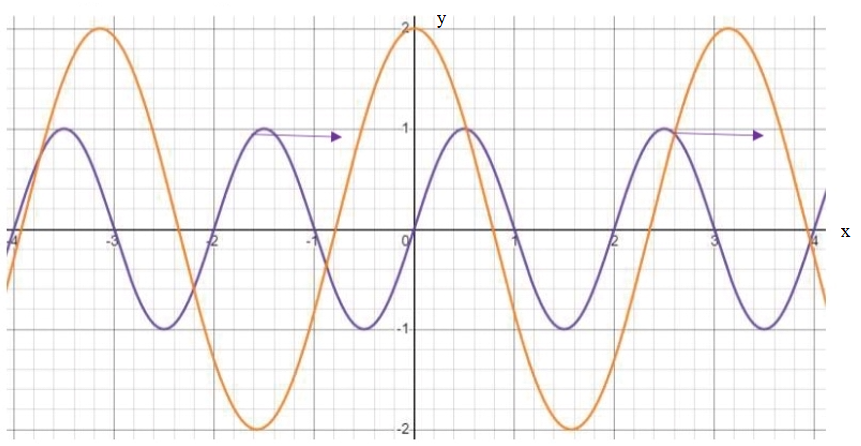Consider two waves which, at time zero, match the two waves in the previous part. But the purple wave, although it initially matches the black wave, moves to the right at a speed of 2 units per second. Any reference to constructive or deconstructive interference refers specifically to what happens at the origin. a) Write the new equation for the black wave that includes the motion. Now write the functional form of the wave formed by superposition of the orange and purple waves. Show any worked required to obtain these answers. b) At t=0, are the orange and purple waves interfering constructively or destructively? c) At what value of time, te, does maximal constructive interference happen? (Note you only need to give the first time this occurs.) What is the resulting amplitude at the origin at this time?
Consider two waves which, at time zero, match the two waves in the previous part. But the purple wave, although it initially matches the black wave, moves to the right at a speed of 2 units per second. Any reference to constructive or deconstructive interference refers specifically to what happens at the origin. a) Write the new equation for the black wave that includes the motion. Now write the functional form of the wave formed by superposition of the orange and purple waves. Show any worked required to obtain these answers. b) At t=0, are the orange and purple waves interfering constructively or destructively? c) At what value of time, te, does maximal constructive interference happen? (Note you only need to give the first time this occurs.) What is the resulting amplitude at the origin at this time?
Related questions
Question

Transcribed Image Text:Consider two waves which, at time zero, match the two waves in the previous part. But the
purple wave, although it initially matches the black wave, moves to the right at a speed of 2
units per second. Any reference to constructive or deconstructive interference refers specifically
to what happens at the origin.
a) Write the new equation for the black wave that includes the motion. Now write the
functional form of the wave formed by superposition of the orange and purple waves.
Show any worked required to obtain these answers.
b) At t=0, are the orange and purple waves interfering constructively or destructively?
c) At what value of time, te, does maximal constructive interference happen? (Note you only
need to give the first time this occurs.) What is the resulting amplitude at the origin at this
time?
d) At what time, ta, does the maximal deconstructive interference occur? (Note you only
need to give the first time this occurs.) What is the amplitude at the origin?
e) Try to come up with a linear function, f, to quantify the amount of constructive and
deconstructive interference. Your answer should depend only on the amplitude of the
wave at the origin, which we'll refer to as A(t). Specifically, construct a function f(A(t))
where f(A(to))=1 and f(A(ta))=-1.
f) Using your function from part (e), determine the resulting value at t=0. Briefly explain
why your answer makes sense.

Transcribed Image Text:Consider the follow image of two waves (i.e., orange and black oscillatory curves). Note that the
horizontal and vertical axes labels are the numbers on the straight lines intersecting at 0,0.
a) What is the amplitude and wavelength of the black and orange lines? (Note the wavelength
may be a whole number or a multiple of pi.)
b) Write out the form of these two waves in terms of a sine or a cosine function times a
constant (i.e. in form Asin(cx) or Acos(cx) ).
c) What is the momentum of a photon associated with each of the two waves? You may
assume the x-axis measures distance in units of nanometers.
Expert Solution
Step 1
Here we will solve the questions from first image as it is considered as first question. Since first question contains more than three subparts, we will solve first three only. Please resubmit the question for next subparts.
Given:

speed of purple/black= 2 unit/s
Trending now
This is a popular solution!
Step by step
Solved in 3 steps with 2 images
